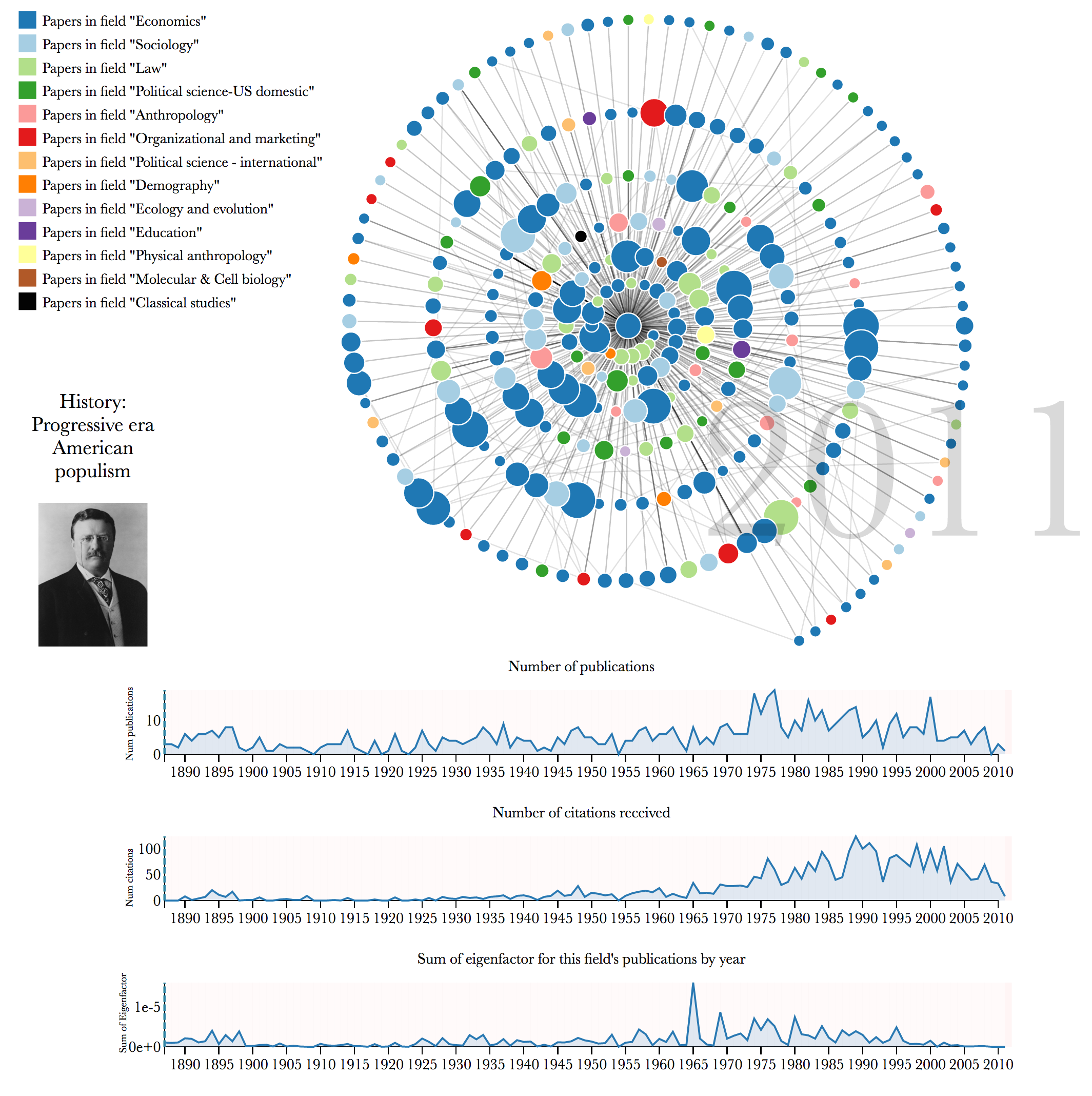Methods
Data
Our database of scholarly publications includes 1.7 million full-text articles from the JSTOR archive and more than 8 million citations between those articles. The methods for naming the fields are described in . We used the citation network–with papers as nodes and citations as links–and clustered the citation graph using the hierarchical version of the map equation . We then hand-labeled 1,765 fields and subfields from the hierarchical partition. We labeled the fields by looking at the top 50 papers in each field.
Papers were ranked using the Article-Level Eigenfactor Score (ALEF). The details of the ranking method can be found at . It takes into account the time-directedness of article-level networks. The ALEF algorithm has performed well in static ranking challenges . We used the article rankings for both the labeling and for identifying the influence of papers that cite the fields of focus (see ).
Currently, the visualization samples 6 fields. We plan to expand to all 1,765 fields in the JSTOR dataset. Users will have the ability to move from field to field and from paper to paper. We plan also to cluster, label, and incorporate other paper archives, including SSRN, arXiv, etc.

Visualization design
shows a screenshot of the final state of the visualization; the full, animated, interactive visualization for a sample of fields can be viewed at http://scholar.eigenfactor.org/fields. We use the open-source JavaScript visualization library D3 , transforming the citation data into a directed egocentric network in which the center (ego) node represents all of the publications in a particular subfield and surrounding (alter) nodes represent individual papers from other fields that have cited work represented in the ego. (The code to generate the visualization will be made available in an open-source repository.) In the figure above, for example, the central subfield is "Progressive era American populism" which is part of the high-level field "History," and the alter nodes are papers in other subfields that have cited this field's papers. The graph diagram shows the ego node as a central circle, and the alter nodes as circles that surround the center in a spiral formation. The surrounding nodes appear one by one according to year of publication and send out links representing citations to the center and to other nodes that appear in the network. Papers that cite the central field multiple times send out multiple overlaid links to the center, so these links appear darker. A year counter shows the publication year of the papers currently appearing. As the nodes appear, the viewer can explore further by mousing over the nodes for more information. The viewer can also explore papers in the center field by mousing over the timeline charts below.
While the total set of the nodes represents any paper that has ever cited a paper authored by the central field, in order to reduce the complexity of the graph we choose a sample of these nodes to visualize, aiming to include influential papers (based on Eigenfactor), from a variety of high-level fields. Currently, the number of nodes is capped at 275, though we are experimenting with alternatives. More complete statistics for the full egocentric network are shown in integrated timeline charts below the graph.
We explore representing the idea of influence in several different ways, and so the network diagram features several different visual encodings of influence. The size of the nodes is scaled by the Eigenfactor metric of each paper, so that larger nodes are easily identified as more influential papers. The color of the nodes encodes the high-level field of the paper according to the paper's cluster assignment for the top-level partition (e.g. "Economics," "Sociology"). This allows a view of to what extent this subdiscipline has had impact that has spread to other disciplines. A field with a more monochrome network will have had most of its influence within one particular field, while a network with more color means more citations from papers in other fields.
We arrived at our design through an iterative design process with the overall goal of creating an accessible, narrative visualization of different dimensions of scholarly influence over time. The use of animation was an important design choice throughout the process, as animation naturally draws attention and can encourage perceptions of narrative. We chose the spiral for the spatial encoding as it allowed us to encode time of publication as radial distance from the center, reinforcing its temporal encoding with the animation. The spiral layout also allows us to include more nodes in a limited space without too much overlap and confusion, addressing the overwhelming "hairball" effect that often comes along with node-link network diagrams.